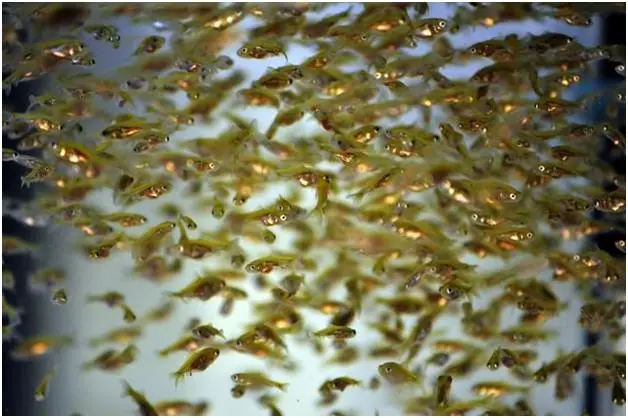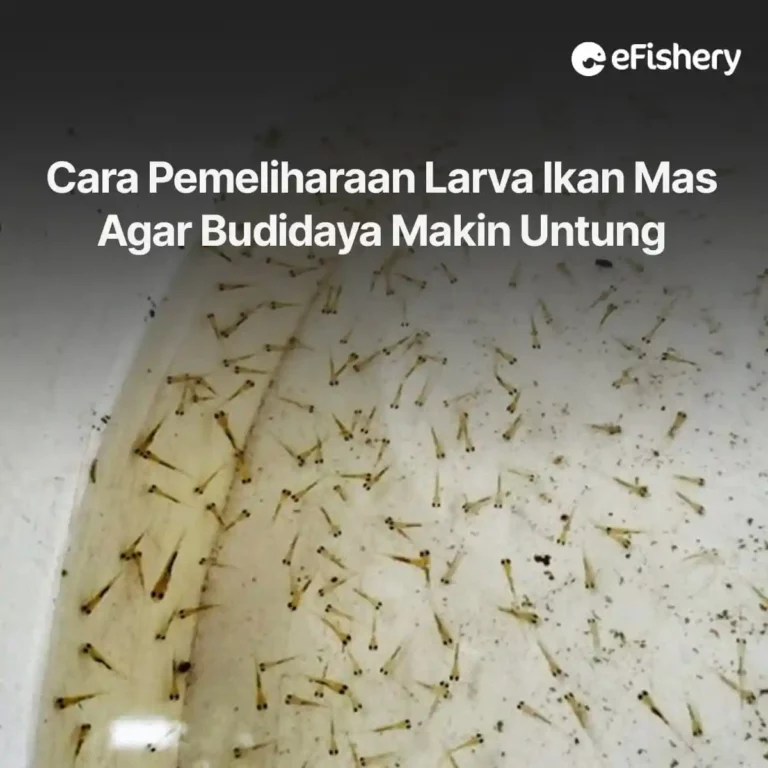Hello, Mr/Mrs Cultivators! Did you know that before entering the enlargement stage, goldfish larvae must be cared for in a special way so they can grow properly?
Carp larvae maintenance includes larval care, water quality management, feeding, and pest and disease control. The process of rearing these larvae can make goldfish have an average survival rate of 81%.
Curious as to how? Check it out in this article, come on!
How to Care for Goldfish Larvae

1. Perawatan Larva
To grow the natural food (plankton) needed by the larvae, the pond must be fertilized using organic fertilizers, inorganic fertilizers, and lime. Fertilization is carried out at the same time as the parent spawning so that by the time the eggs hatch, the natural food needed by the larvae is available in the pond.
If the fertilization process is complete, fill the pond with water gradually until the water level reaches 75 cm from the bottom of the pond. To maximize the growth of carp larvae, you can move the larvae that are 2-3 days old to the nursery pond
2. Water Quality Management
The water quality of goldfish larvae rearing ponds must meet various requirements, both in terms of physics, chemistry, and biology. To ensure that the growth of carp larvae remains good, environmental conditions must also be suitable for larval life. Some things that must be considered from water quality are temperature, brightness, oxygen, and ammonia levels.
Temperature greatly affects the life and growth of carp larvae. Water temperature has a very large influence on the process of exchanging substances or the metabolism of living things. In addition, temperature also affects the level of dissolved oxygen in the water, growth and appetite of fish. Tropical fish grow well at water temperatures between 25–32ºC.
Oxygen is one of the important limiting factors in goldfish farming. Although some types of fish can survive in waters with an oxygen concentration of 3 ppm, the minimum concentration that fish should be able to live well with is 5 ppm. In waters with oxygen concentrations below 4 ppm, fish are still able to survive, but their appetite is low or none at all, so their growth is stunted. Fish will die or be stressed if the oxygen concentration reaches 0 ppm.
In an effort to enlarge carp larvae, the concentration of oxygen dissolved in the pond will decrease because oxygen is used for breathing fish and other organisms. Oxygen in rearing ponds is also used for chemical reactions in organic matter such as fish waste, leftover feed, and decomposition of dead plants and animals. However, the decrease in oxygen concentration must be balanced with the addition of oxygen from photosynthesis which takes place during the day from the process of mixing air with water caused by wind on the surface of the water.
3. Feeding
Goldfish are omnivorous fish, which means they eat all kinds of food. For goldfish larvae, good feed is feed that can improve the quality of water color, accelerate growth, ward off disease germs, help increase body size, and accelerate gonadal maturation. The feed given must also have a balanced nutritional content. Nutritional balance is regulated based on body size, fish age, and water temperature.
Overfeeding is a bad thing. If given excessive feed, the body of the carp larvae becomes fat quickly and is susceptible to disease. Vice versa, lack of feed can cause the carp larvae to become thin, have poor color quality, grow slowly, and are susceptible to disease.
In addition to natural food from what grows in ponds (plankton), goldfish larvae can also be given food in the form of egg yolk suspension. Giving egg yolk suspension is done 5 times per day (1 item for about 100,000 larvae).
4. Hama dan Penyakit
Pest and disease attack is one of the causes of failure of goldfish larvae maintenance. Pests are also a source of disease because they can carry pathogens. A large population of pests in the pond will make the water quality decrease. Pests can cause disturbance to the fish that are kept. Pests can cause disease attacks, either directly or indirectly. Pests can be predators (predators), competitors (competitors), destroyers of cultivation facilities, and thieves.
Pest control can be done mechanically, namely killing directly the pests found in the fish-keeping area. Pests can be prevented by installing traps and localizing the entire pond area with a wall fence so that pests cannot enter.
In carp larvae, disease can be caused by living and non-living bodies. Living organisms that cause disease in fish are viruses, fungi, bacteria, protozoa, worms, and tiny shrimp. Meanwhile, the causes of disease that are not living organisms are the physical properties of water, the chemical properties of water, and feed that is not suitable for goldfish life.
Dapatkan Dukungan untuk Mengembangkan Budidaya Ikan Mas dari Kabayan!
Apakah Bapak/Ibu sedang berniat untuk mengembangkan usaha budidaya ikan mas untuk memenuhi permintaan pasar?
Jangan khawatir, sekarang ada Kabayan from eFishery! Kabayan (Kasih, Bayar Nanti) merupakan penyedia akses ke institusi finansial terpercaya serta diawasi/berizin OJK yang bisa mendukung Bapak/Ibu untuk mengembangkan budidaya. Dengan Kabayan, Bapak/Ibu bisa mendapatkan pakan berkualitas dan sarana budidaya lainnya dengan sistem pembayaran tempo yang dapat dibayarkan setelah panen.
Isi formulir di bawah ini untuk mendapatkan akses ke Kabayan!
Get Access to Financial Institutions that are Trusted, Registered & Supervised by OJK!
Fill in your personal data in the following form. Our team will immediately contact you via the number cellphone attached. Make sure the data entered is correct.
Questions About Goldfish Larvae
Goldfish larvae food is a suspension of egg yolk and plankton.
- https://repository.polipangkep.ac.id/uploaded_files/dokumen_isi/Monograf/WINDRA%20BUMBUNGAN%201%20-%203.pdf
